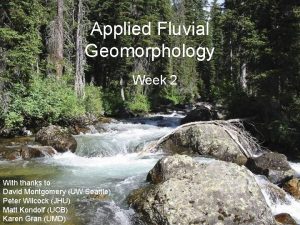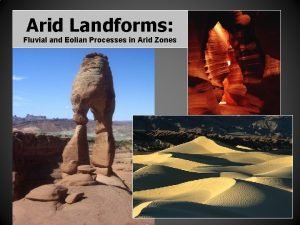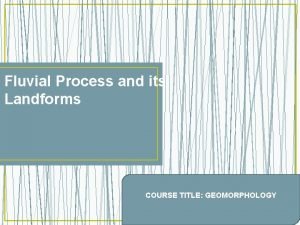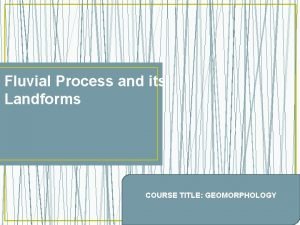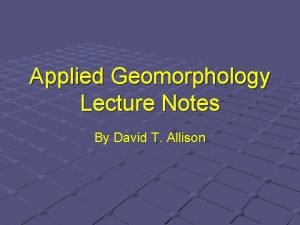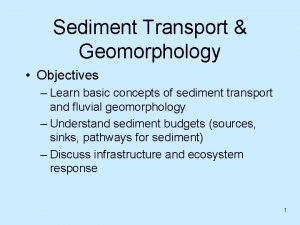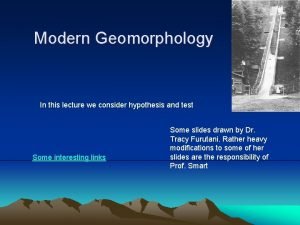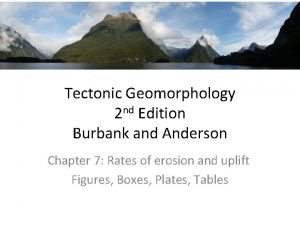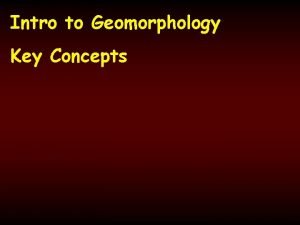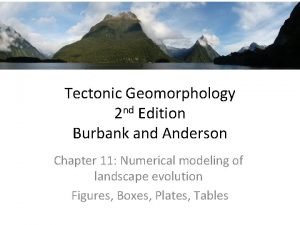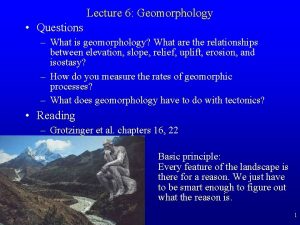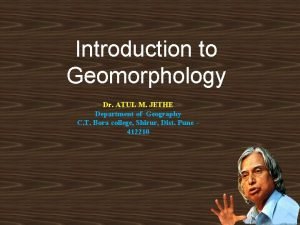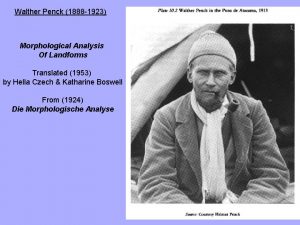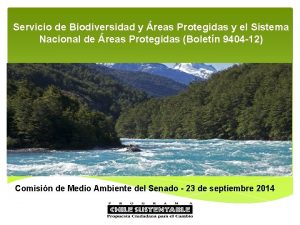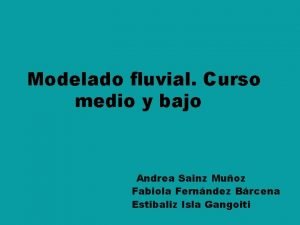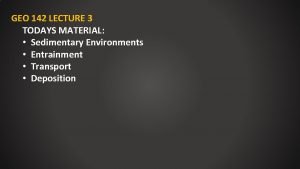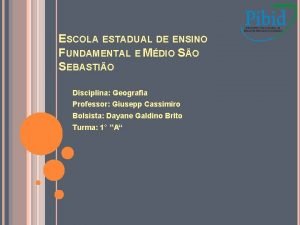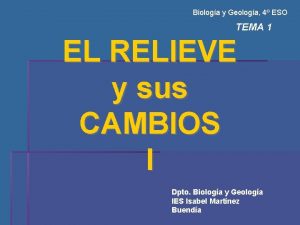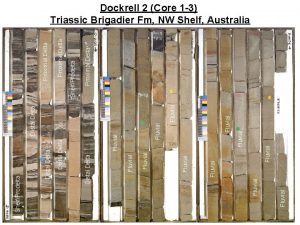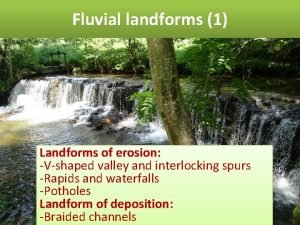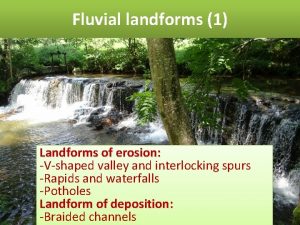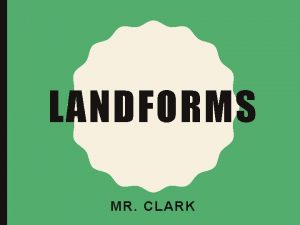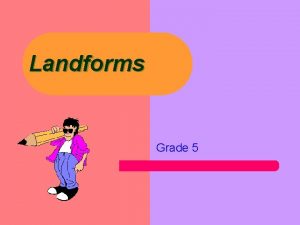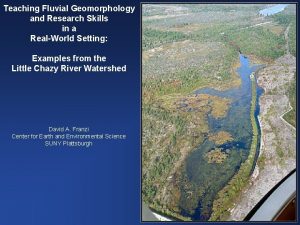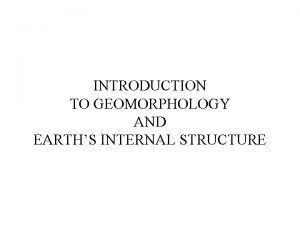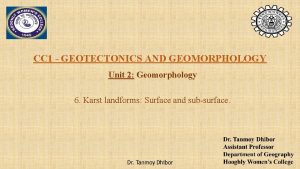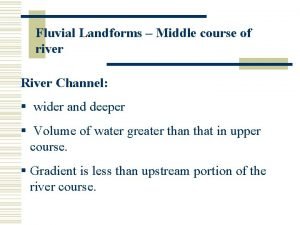Fluvial Process and its Landforms COURSE TITLE GEOMORPHOLOGY



















- Slides: 19

Fluvial Process and its Landforms COURSE TITLE: GEOMORPHOLOGY

What are Fluvial Processes? • Collection of surface water into organized sequence of channelized forms whereby sediment is transported from the continents to ocean basins.

Define the term “fluvial”. What is a fluvial process? • Stream-related processes are termed fluvial (from the Latin fluvius, meaning river). Insolation (solar energy) is the driving force of fluvial systems, operating through the hydrologic cycle and working under the influence of gravity. • Denudation (degradation of landscape) by water dislodges, dissolves, or removes surface material as erosional fluvial processes. Thus, streams supply weathered and wasted sediments for transport to new locations, where they are laid down in a process known as

Fluvial Processes and Landforms shaped by running water are described as fluvial landforms. The work of streams consists of three closely related activities - erosion, transportation, and deposition, creating two major types of fluvial landforms: erosional landforms and depositional landforms.

What is the sequence of events that takes place as a stream dislodges material? • Water dislodges, dissolves, or removes surface material in the process called erosion. Streams produce fluvial erosion, in which weathered sediment is picked up for transport to new locations. Thus, a stream is a mixture of water and solids, the solids are carried by solution, suspension, and by mechanical transport. Materials are then laid down by another process, deposition.

River • A river is a natural flowing watercourse, usually freshwater, flowing towards an ocean, sea, lake or another river. • Running water is the most important agent of erosion on the continents and the stream valleys are the most common landforms. • Rivers flowing to the oceans drain about 68 % of the Earth's land surface. The remainder of the land either is covered by ice or drains to closed basins. • River gradually mould the land by eroding away the material in some place and depositing it in other

• A RIVER SYSTEM CAN BE DIVIDED INTO THREE SUBSYSTEMS: • collecting system (branches) -- consisting of a network of tributaries in the headwater region, collects and funnels water and sediment to the main stream • transporting system (trunk) -- the main trunk stream, which functions as a channelway through which water and sediment move from the collecting area toward the ocean. (Erosion and deposition also occur in a river's transporting system) • dispersing system (roots) -- consists of a network

Parts of River • tributary : a stream flowing into or joining a larger stream • distributary : numerous stream branches into which a river divides where it reaches its delta • upstream : moves toward headwater (up the regional slope of erosion) • downstream : moves toward mouth of river (delta) • Delta : a large, roughly triangular body of sediment deposited at the mouth of a river • Meander : a broad, looping bend in a river • Braided : river is divided into multiple channels by alluvial islands. Braided rivers tend to have steeper gradients

Common River Terms • Source – The place where a river begins. • Course – The route the river takes to the sea • Tributary – A small river that joins a larger river. • Confluence – The point where the tributary joins the river.


Common River Terms • Mouth – The point where the river enters the sea. • Estuary – The part of the mouth that is tidal. • Basin – The area of land drained by a river. • Watershed – The high ground separating one river basin from another.

The River’s Journey • Rivers usually begin in the mountains. • They flow downhill onto flat land into the sea.


Can you work out what the river is trying to do by using this diagram?

The Stages of a River’s Journey • As the river flows from it’s source to the sea it goes through 3 stages. These are, • The Upper or Youthful Stage • The Middle or Mature Stage • The Lower or Old Stage

The Youthful River • The youthful river has a small amount of water but it travels very quickly down the steep mountain slope. • Most of its energy is used to erode (wear away) the landscape. • This erosion (wearing away) occurs in 4 ways.

4 Processes of River Erosion • Hydraulic Action – The force of the moving water wears away the banks and bed of the river. • Abrasion – Small stones carried by the river wear away at the banks and bed of the river.

4 Processes of River Erosion • Attrition – The small stones in the river are worn down and broken up as they hit off each other. • Solution – Rocks and soil are dissolved by acids in the water.

 Applied fluvial geomorphology
Applied fluvial geomorphology Fluvial landforms
Fluvial landforms Course number and title
Course number and title Fluvial process
Fluvial process What is a fluvial process
What is a fluvial process Applied geomorphology notes
Applied geomorphology notes Lane's balance
Lane's balance Hypothesis in geomorphology
Hypothesis in geomorphology Tectonic
Tectonic Dynamic equilibrium in geomorphology
Dynamic equilibrium in geomorphology Tectonic
Tectonic Forces
Forces Application of geomorphology
Application of geomorphology Fluvial cycle of erosion by davis and penck
Fluvial cycle of erosion by davis and penck Modelado
Modelado Modelado fluvial
Modelado fluvial Modelado fluvial
Modelado fluvial Alluvial vs fluvial
Alluvial vs fluvial Vale fluvial
Vale fluvial Procesos fluviotorrenciales
Procesos fluviotorrenciales
